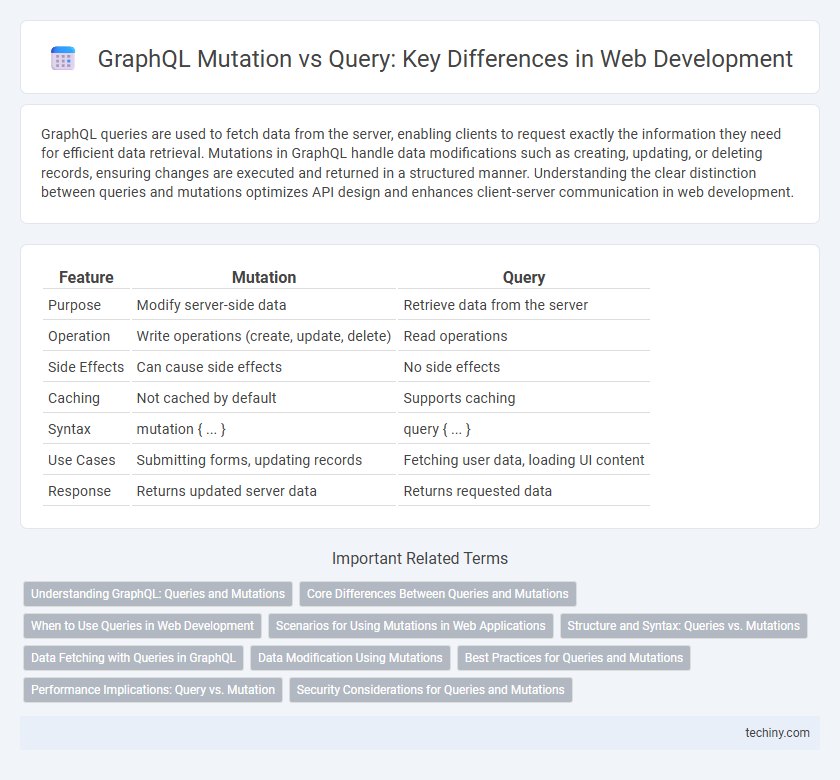GraphQL queries are used to fetch data from the server, enabling clients to request exactly the information they need for efficient data retrieval. Mutations in GraphQL handle data modifications such as creating, updating, or deleting records, ensuring changes are executed and returned in a structured manner. Understanding the clear distinction between queries and mutations optimizes API design and enhances client-server communication in web development.
Table of Comparison
| Feature | Mutation | Query |
|---|---|---|
| Purpose | Modify server-side data | Retrieve data from the server |
| Operation | Write operations (create, update, delete) | Read operations |
| Side Effects | Can cause side effects | No side effects |
| Caching | Not cached by default | Supports caching |
| Syntax | mutation { ... } | query { ... } |
| Use Cases | Submitting forms, updating records | Fetching user data, loading UI content |
| Response | Returns updated server data | Returns requested data |
Understanding GraphQL: Queries and Mutations
GraphQL queries retrieve data from a server, allowing clients to specify exactly what information they need, optimizing network efficiency and response size. Mutations in GraphQL modify server-side data and often return the updated state, supporting operations like create, update, and delete. Understanding the distinction between queries and mutations is essential for designing effective GraphQL APIs and managing data flow in web development projects.
Core Differences Between Queries and Mutations
Queries in GraphQL are designed to fetch data without causing side effects, enabling efficient read operations from a server. Mutations, on the other hand, are used to modify server-side data, supporting create, update, or delete actions while potentially returning updated result sets. The core difference lies in their intent and effect: queries are idempotent and safe for repetitive execution, whereas mutations alter data state and usually require careful handling to maintain data consistency.
When to Use Queries in Web Development
Queries in GraphQL are essential for retrieving data from the server, making them ideal for fetching read-only information such as user profiles, lists, and application settings. They ensure efficient data loading by allowing precise requests for only the needed fields, reducing over-fetching and improving performance. Use queries whenever you need to access or display data without altering the underlying database state.
Scenarios for Using Mutations in Web Applications
Mutations in GraphQL are essential for scenarios that require creating, updating, or deleting data on the server, such as submitting user forms, managing inventory, or handling user authentication processes. These operations ensure data consistency and trigger side effects, including database updates or real-time notifications. Queries, by contrast, are optimized for retrieving data without causing modifications, making mutations the preferred choice for any interaction involving state changes in web applications.
Structure and Syntax: Queries vs. Mutations
GraphQL queries retrieve data with a structured syntax resembling JSON, specifying fields and nested objects to define the exact shape of the requested data. Mutations, in contrast, follow a similar structure but are designed to modify server-side data, often requiring input arguments for creation, updating, or deletion operations. Both use a declarative approach, but queries are read-only while mutations signal intent to change data, influencing response payloads and execution flow.
Data Fetching with Queries in GraphQL
Data fetching with queries in GraphQL allows clients to request specific fields from the server, reducing over-fetching and under-fetching of data. Queries operate as read-only fetch operations, retrieving data without causing side effects or modifying server state. Efficient use of queries enhances performance by enabling precise data retrieval in a single request, streamlining client-server communication.
Data Modification Using Mutations
Mutations in GraphQL are specifically designed for data modification operations such as creating, updating, or deleting records on the server. Unlike queries, which are used to fetch and read data, mutations trigger state changes and often return the updated data as part of their response. Efficient use of mutations ensures atomic updates and maintains the consistency of the API by encapsulating all data modification logic within a single operation.
Best Practices for Queries and Mutations
GraphQL best practices emphasize using queries for fetching data and mutations for modifying server-side data to maintain clarity and efficiency. Structuring queries to request only necessary fields enhances performance and reduces payload size, while mutations should be designed to reflect single, atomic operations to ensure predictable data changes. Consistent naming conventions, request batching for queries, and clear error handling strategies improve maintainability and user experience in web development projects.
Performance Implications: Query vs. Mutation
GraphQL queries optimize performance by fetching only the requested data without altering the server state, enabling efficient caching and reduced network overhead. Mutations, however, involve state changes that often require revalidation or cache invalidation, potentially leading to increased server processing time and slower response times. Understanding this distinction is crucial for designing performant APIs that balance real-time updates with data retrieval efficiency.
Security Considerations for Queries and Mutations
GraphQL queries should be designed to prevent excessive data exposure by implementing strict validation and depth limiting, reducing risks of data leaks and denial-of-service attacks. Mutations require robust authentication and authorization controls to ensure only authorized users can modify data, protecting against unauthorized changes and potential data corruption. Both queries and mutations benefit from rate limiting, input sanitization, and monitoring to detect suspicious activities and enhance overall API security.
mutation vs query (GraphQL) Infographic

 techiny.com
techiny.com